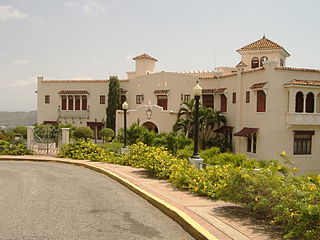
Ponce is a city and a municipality on the southern coast of Puerto Rico. The most populated city outside the San Juan metropolitan area, Ponce was founded on August 12, 1692 and is named after Juan Ponce de León y Loayza, the great-grandson of Spanish conquistador Juan Ponce de León. Ponce is often referred to as La Perla del Sur, La Ciudad Señorial, and La Ciudad de las Quenepas.

The following is an alphabetical list of articles related to the Commonwealth of Puerto Rico.

Teatro La Perla is a historic theater in the city of Ponce, Puerto Rico. Inaugurated in 1864, it is the second oldest theater of its kind in Puerto Rico, but "the largest and most historic in the Spanish-speaking Caribbean." The theater was named La Perla in honor of the Virgin of Montserrat, known as "The Pearl of the Mediterranean." It is located in barrio Tercero, in the Ponce Historic Zone.

Río Portugués is a river in the municipality of Ponce, Puerto Rico. In the 19th century, it was also known as Río de Ponce. Twenty-one bridges for motor vehicle traffic span Río Portugués in the municipality of Ponce alone. The river is also known as Río Tibes in the area where it flows through barrio Tibes in the municipality of Ponce. Río Portugués has a length of nearly 30 kilometers (19 mi) and runs south from the Cordillera Central mountain range into the Caribbean Sea. The Portugués is one of the best-known rivers in Ponce because of its prominent zigzagging through the city and its historical significance. The river is historically significant because the city of Ponce had its origins on its banks. It was originally known as Río Baramaya. It has its mouth at 17°58′51″N66°37′26″W. This river is one of the 14 rivers in the municipality.

Bucaná River is a river in the municipality of Ponce, Puerto Rico. Río Bucaná has its origin in barrio Machuelo Arriba where it forms at an altitude of 115 feet (35 m). It forms from the confluence of Río Cerrillos and Río Bayagán.[note a] It is also fed by Río Portugues during its southernly run. Río Bucaná used to run for some 29.5 kilometers (18.3 mi) prior to canalization and other diversion work by the U.S. Army Corps of Engineers. It now runs for 5.89 miles (9.48 km) to drain into the Caribbean Sea. This river is one of the 14 rivers in the municipality.
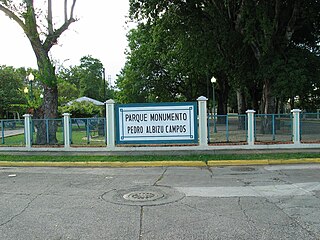
The Parque Pedro Albizu Campos is a passive recreational park in the city of Ponce, Puerto Rico. It was dedicated on 12 September 1991, to the memory of Puerto Rican Nationalist leader Pedro Albizu Campos by the Government of the Autonomous Municipality of Ponce. Dr. Pedro Albizu Campos was born in Ponce on 12 September 1891. He was raised in Ponce and lived most of his life there as well.

The Ponce City Hall is a historic city hall in Ponce, Puerto Rico. It is located it the center of the city, on Calle Degetau, across from Plaza Degetau in the Ponce Historic Zone. The building serves as the seat of the executive branch of government of the Autonomous Municipality of Ponce, including the office of the mayor of Ponce. Built in 1840, it is the oldest colonial building in the city. The building was listed on the U.S. National Register of Historic Places in 1986 as Casa Alcaldía de Ponce-City Hall.
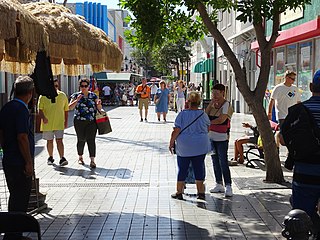
Paseo Atocha is a pedestrian shopping mall in the Ponce Historic Zone, a historic district in Ponce, Puerto Rico. For over a century the narrow Calle Atocha was bustling retail center opened to vehicular traffic, yet flooded with shoppers. Congestion and pedestrian safety led the municipal government to close the two blocks of Calle Atocha from Calle Isabel to Calle Vives to motor vehicles in 1991. Several years later, the closure was expanded to include the block from Calle Vives to Calle Victoria. This last segment coincides with the western perimeter of the historic Plaza de Mercado Isabel II city market. Not the bustling commercial spot it once was, today it is still actively frequented by shoppers, though in much reduced numbers. It is visited annually by thousands of locals and tourists alike and is considered one of the city’s main places of interest.

El Tuque is a beach and family recreational and tourist complex in the Punta Cucharas sector of Barrio Canas in Ponce, Puerto Rico. It was designed in the early 1960s by Luis Flores, an architect from Cayey, Puerto Rico. It is located on PR-2, Km 220.1, in the El Tuque sector of Barrio Canas in Ponce. The sector of El Tuque is considered Puerto Rico's largest populated sector. The beach opened on 17 July 1965.

Barrio Playa, also known as Playa de Ponce, Ponce Playa, or La Playa, is one of the thirty-one barrios that comprise the municipality of Ponce, Puerto Rico. Along with Bucaná, Canas, Vayas, and Capitanejo, Playa is one of the municipality's five coastal barrios. Barrio Playa also incorporates several islands, the largest of which is Caja de Muertos. It was founded in 1831.

Parque de la Abolición is a city park in Barrio Cuarto, Ponce, Puerto Rico. It was the first park in the Caribbean to commemorate the abolition of slavery. It was built in 1874 and renovated in 1956.
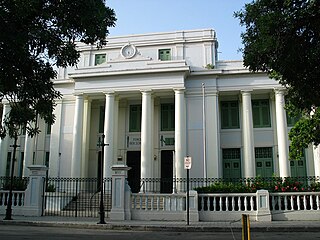
The Ponce High School is public educational institution in Ponce, Puerto Rico, offering grades nine through twelve. The school's main building is a historic structure located on Cristina Street, in the Ponce Historic Zone. From its beginning the school has secured a unique place in Puerto Rico's educational history. Of over 3,000 schools erected in Puerto Rico in the first quarter of the twentieth century, Ponce High was the largest, "at a time enrolling more students than all the other Puerto Rico high schools combined", and for many years enrolling more students than any other high school in Puerto Rico. The cost of the building in 1915 dollars was $150,000 USD. The building was listed on the U.S. National Register of Historic Places on 4 August 1987. The school has the only diamond-level DECA chapter in Puerto Rico. The Ponce High School building is "among the most important public buildings ever built in Puerto Rico." The school is the oldest continuously-operating high school in Puerto Rico.

Cerrillos River is a river in the municipality of Ponce, Puerto Rico. Río Cerrillos has its origin in barrio Anón and runs south until it feeds into Bucaná River. Río Cerrillos is commonly known by the locals as Maragüez River, because most of its course runs through Barrio Maragüez. This river is one of the 14 rivers in the municipality. The river has a discharge of 24,000 cubic feet per second, making it the second most affluent river in the municipality after Río Jacaguas.

Parque del Tricentenario is a passive urban park in the city of Ponce, Puerto Rico. The park was built to commemorate the 300th anniversary of the founding of the city. It was inaugurated during the mayoral administration of mayor Rafael Cordero Santiago.

The Ponce Historic Zone is a historic district in downtown Ponce, Puerto Rico, consisting of buildings, plazas and structures with distinctive architectures such as Neoclásico Isabelino and the Ponce Creole, a local architectural style developed between the 19th- and early 20th-centuries. The zone goes by various names, including Traditional Ponce, Central Ponce, Historic Ponce, and Ponce Historic District. Although not yet listed in the National Register of Historic Places, the Ponce Historic Zone was added to the Puerto Rico Register of Historic Sites and Zones on February 2, 1989.

The Luis A. "Wito" Morales Park is a park in the municipality of Ponce, Puerto Rico. It is part of the Lake Cerrillos Dam recreational area.
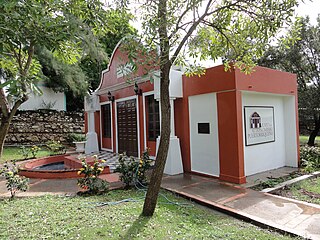
The Museo del Autonomismo Puertorriqueño is a small museum in Ponce, Puerto Rico, that showcases the political history of Puerto Rico with an emphasis on the contributions made by the municipality of Ponce and its residents. The museum was established on 7 September 2006.

Museo Castillo Serrallés, a.k.a. Museo de la Caña y el Ron, is an agricultural museum in the city of Ponce, Puerto Rico, that showcases the history of sugar cane, its derivative rum industry, and their impact in the economy of Puerto Rico. The most notorious feature of the museum is the building it occupies. The building is a large four-story structure built in the 1930s for the owner of Ponce's Destileria Serralles, one of Puerto Rico's largest rum distilleries. The distillery was once also home to Puerto Rico's largest sugar-factory called Central Mercedita, producers of the Snow White sugar brand. The building, known as Castillo Serrallés, was designed by Pedro Adolfo de Castro in 1930 in the Spanish Colonial Revival style.

Museo Parque de Bombas is a museum located inside the historic Parque de Bombas in the Ponce Historic Zone in Ponce, Puerto Rico.

Bahía de Ponce is a bay in Barrio Playa, Ponce, Puerto Rico. The Bay is home to the most important commercial harbor on the Puerto Rico south coast and the second largest in Puerto Rico. The Cardona Island Light is located on the Bay to mark the way into the Bay from the nearby Caja de Muertos Light.





















